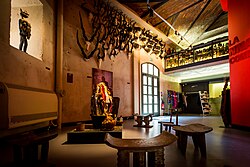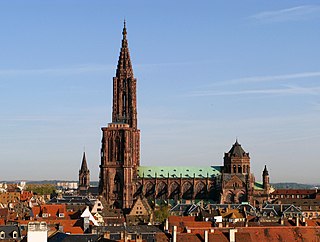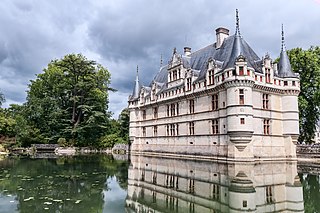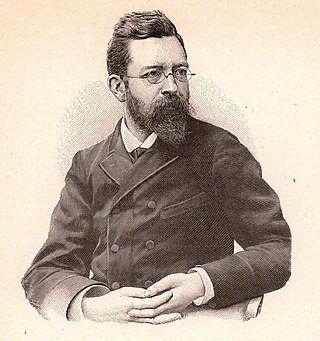 The entrance hall of the Museum | |
| Established | 2014 |
|---|---|
| Location | 4, rue de Koenigshoffen |
| Type | Museum and castle |
| Website | |
The Voodoo Castle (previously known as the Voodoo Museum) is located in the city of Strasbourg in the department of Bas-Rhin, Alsace.
 The entrance hall of the Museum | |
| Established | 2014 |
|---|---|
| Location | 4, rue de Koenigshoffen |
| Type | Museum and castle |
| Website | |
The Voodoo Castle (previously known as the Voodoo Museum) is located in the city of Strasbourg in the department of Bas-Rhin, Alsace.

Founded in January 2014 by Marie-Luce and Marc Arbogast and managed by a non-profit local organization, this museum presents one of the most important collections of private Voodoo art in France. [1]
It is situated in the old water castle of Strasbourg, which was built in 1878 and listed as a historic monument of France in 1984. [2]
The museum opens its doors from Wednesday to Sunday, from 2 PM to 6 PM. Groups larger than 8 can be accommodated outside of these hours with a reservation. The collection is also suitable for younger visitors.
The collection, which is curated by Marie-Luce and Marc Arbogast, consists of nearly 1060 Voodoo objects originating in Togo, Benin, Ghana and Nigeria. 220 of these pieces are permanently on display at the exhibition titled "Voodoo as an Art to See Differently", or "Le Vodou, l’Art de Voir Autrement." It is by far the biggest collection of African Voodoo art pieces in the world.
The museum's collector has expressed the following words: "The Voodoo Castle is the manifestation of my passion for Africa, colliding with my curiosity in its traditional knowledge, chemistry, and hunting. […] Like my travels in Africa, I would like for this Museum as well as its collections to awaken supernatural meetings, grabbing always and still the curiosity for the human nature, in the spirit of creativity; it is there that presides the creation of such surprising art pieces, sometimes off-putting, but always profoundly human.[ citation needed ]
Sur la piste du vaudou, a documentary film by David Arnold, for Bix Films/France Télévisions, 2012, 52 min

Strasbourg is the prefecture and largest city of the Grand Est region of eastern France and the official seat of the European Parliament. Located at the border with Germany in the historic region of Alsace, it is the prefecture of the Bas-Rhin department.

Maine-et-Loire is a department in the Loire Valley in the Pays de la Loire region in Western France. It is named after the two rivers, Maine and the Loire. It borders Mayenne and Sarthe to the north, Loire-Atlantique to the west, Indre-et-Loire to the east, Vienne and Deux-Sèvres to the south, Vendée to the south-west, and Ille-et-Vilaine to the north-west. It also borders Ille-et-Vilaine in the north for just 20 yards (19 m), France's shortest department boundary. Its prefecture is Angers; its subprefectures are Cholet, Saumur and Segré-en-Anjou Bleu. Maine-et-Loire had a population of 818,273 in 2019.

The Loire Valley, spanning 280 kilometres (170 mi), is a valley located in the middle stretch of the Loire river in central France, in both the administrative regions Pays de la Loire and Centre-Val de Loire. The area of the Loire Valley comprises about 800 square kilometres (310 sq mi). It is referred to as the Cradle of the French and the Garden of France due to the abundance of vineyards, fruit orchards, and artichoke, and asparagus fields, which line the banks of the river. Notable for its historic towns, architecture, and wines, the valley has been inhabited since the Middle Palaeolithic period. The oldest known Neanderthal engravings have been found a cave in La Roche-Cotard which have been dated to more than 57,000 years ago. In 2000, UNESCO added the central part of the Loire River valley to its list of World Heritage Sites.

The Château de Chaumont, officially Château de Chaumont-sur-Loire, is a castle (château) in Chaumont-sur-Loire, Centre-Val de Loire, France. The castle was founded in the 10th century by Odo I, Count of Blois. After Pierre d'Amboise rebelled against Louis XI, the king ordered the castle's destruction. Later in the 15th century Château de Chaumont was rebuilt by Charles I d'Amboise. Protected as a monument historique since 1840, the château was given into state ownership in 1938 and is now open to the public.

The Château de Montsoreau is a Flamboyant Gothic castle in the Loire Valley, directly built in the Loire riverbed. It is located in the market town of Montsoreau, in the Maine-et-Loire département of France, close to Saumur, Chinon, Fontevraud-l'Abbaye and Candes-Saint-Martin. The Château de Montsoreau is situated at the confluence of two rivers, the Loire and the Vienne, and the meeting point of three historical regions: Anjou, Poitou, and Touraine. It is the only château of the Loire Valley built directly in the Loire riverbed.

The Château du Clos Lucé, formerly called Manoir du Cloux, is a large château located in the center of Amboise, in the department of Indre-et-Loire, in the Centre-Val de Loire region of France. It is located in the natural Val de Loire region. Built by Hugues d'Amboise in 1471, the palace has known several famous owners such as the French king Charles VIII and Leonardo da Vinci. Clos Lucé is 500 metres from the royal Château d'Amboise, to which it is connected by an underground passageway.

Pays de la Loire is one of the eighteen regions of France, located on the country's Atlantic coast. It was created in the 1950s to serve as a zone of influence for its capital and most populated city, Nantes, one of a handful of French "balancing metropolises". In 2020, Pays de la Loire had a population of 3,832,120.

Jean-Marc Nattier was a French painter. He was born in Paris, the second son of Marc Nattier (1642–1705), a portrait painter, and of Marie Courtois (1655–1703), a miniaturist. He is noted for his portraits of the ladies of King Louis XV's court in classical mythological attire.

The Château d'Anet is a château near Dreux, in the Eure-et-Loir department in northern France, built by Philibert de l'Orme from 1547 to 1552 for Diane de Poitiers, the mistress of Henry II of France. It was built on the former château at the center of the domains of Diane's deceased husband, Louis de Brézé, seigneur d'Anet, Marshal of Normandy and Master of the Hunt.

Rohan Castle, also known as Château Neuf, is an eighteenth-century neoclassical palace in the city of Saverne in Alsace, France. It was one of the residences of Archbishops of Strasbourg, rulers of the Prince-Bishopric of Strasbourg, which was an ecclesiastical principality of the Holy Roman Empire from the 13th century until 1803. A series of members of the House of Rohan held the see in the 18th century. The 140 metre wide façade of red Vosges sandstone is considered to be one of the most impressive examples of its kind.

The Palais Rohan in Strasbourg is the former residence of the prince-bishops and cardinals of the House of Rohan, an ancient French noble family originally from Brittany. It is a major architectural, historical, and cultural landmark in the city. It was built next to Strasbourg Cathedral in the 1730s, from designs by Robert de Cotte, and is considered a masterpiece of French Baroque architecture. Since its completion in 1742, the palace has hosted a number of French monarchs such as Louis XV, Marie Antoinette, Napoleon and Joséphine, and Charles X.

Eugène Trutat was a French naturalist, mountaineer, pyreneist, geologist and photographer, who was curator of the Museum of Toulouse.

Pierre Girault de Nolhac, known as Pierre de Nolhac, was a French historian, art historian and poet.

Louis-Frédéric Schützenberger was a German-French painter.

Albert Lebourg, birth name Albert-Marie Lebourg, also called Albert-Charles Lebourg and Charles Albert Lebourg, was a French Impressionist and Post-Impressionist landscape painter of the Rouen School. Member of the Société des Artistes Français, he actively worked in a luminous Impressionist style, creating more than 2,000 landscapes during his lifetime. The artist was represented by Galerie Mancini in Paris in 1896, in 1899 and 1910 by : Galerie Bernheim-Jeune, 1903 and 1906 at the Galerie Paul Rosenberg, and 1918 and 1923 at Galerie Georges Petit.

Château de Hunebourg is a rock castle that lies to the west of Neuwiller-lès-Saverne in the French département of Bas-Rhin on a 425-metre-high sandstone rock outcrop. It is accessible from the valley of the Zinsel du Nord. The original castle was built in the 12th-13th century, but very little remains from this period. The castle was reconstructed in a neo-romanesque style in the 1930s. It is a listed historical monument since 2007.

Count Armand Doria (1824-1896) was a French aristocrat, art collector and patron. He served as the mayor of Orrouy from 1864 to 1896. He acquired a significant collection of impressionist works, including paintings subsequently exhibited in museums in Europe and the United States.

Voodoo: Truth and Fantasy is a 1993 illustrated monograph on Haitian Vodou. Written by the Haitian sociologist of religion Laënnec Hurbon, and published in pocket format by Éditions Gallimard as the 190th volume in their 'Découvertes' collection.

The municipal museum of Saverne, a small town in the Bas-Rhin department of France, is the oldest museum in the historic Alsace region outside of Strasbourg and Colmar, having been founded in 1858. It is located in the former Rohan Castle since 1952.
Rachel Beauvoir-Dominique was a Haitian anthropologist and Vodou mambo.